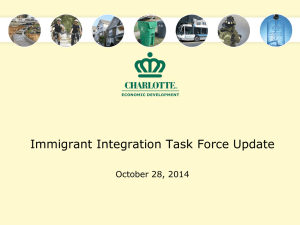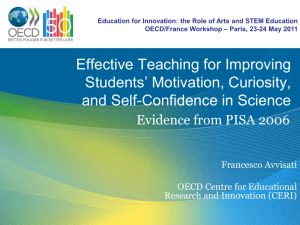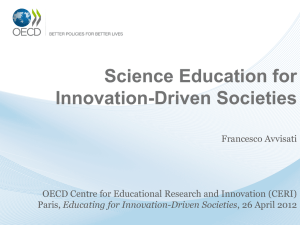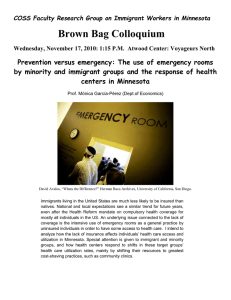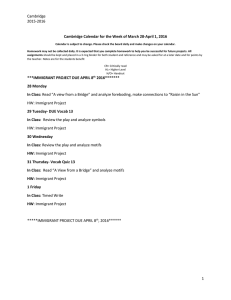OECD Thematic Review on Migrant Education: Progress Reporting
advertisement
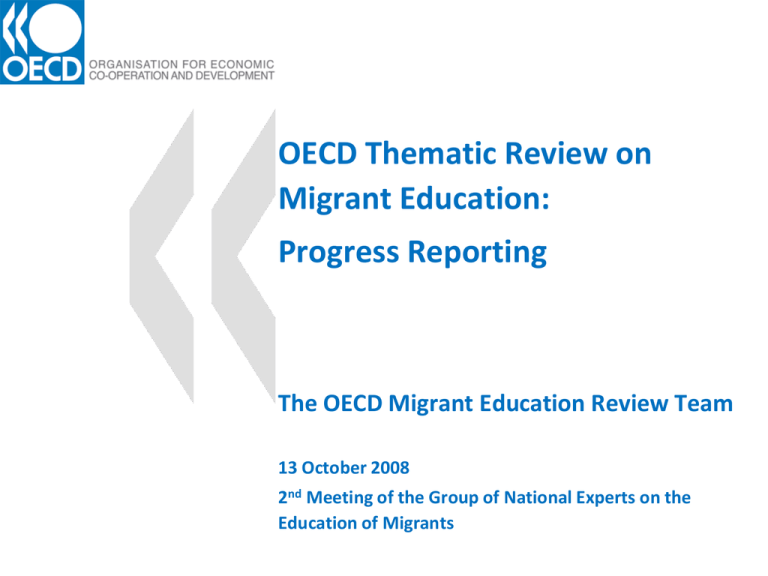
OECD Thematic Review on Migrant Education: Progress Reporting The OECD Migrant Education Review Team 13 October 2008 2nd Meeting of the Group of National Experts on the Education of Migrants Presentation this morning 1. Brief summary of the project 2. General overview 3. Results from Phase I of the project Brief Summary about the Project • Project’s overarching question: What policies will promote successful education outcomes of first and second generation immigrant students? • Focus: Education policies Education outcomes - Access, Participation, Student Performance • Scope: Pre-school, primary and secondary (and transition to higher education) • Participation (meetings and questionnaires): all OECD member countries • Review countries (7 countries): Austria, Belgium (Flemish Community), Denmark, Ireland, the Netherlands, Norway, and Sweden • Working methods: Mix of desk-based research and country visits; Mix of quantitative and qualitative research • Timeline: January 2008- December 2009 General Overview 2008 01 02 Process 03 04 05 06 07 08 09 Phase I: Pre-Visit 10 11 12 2009 01 02 03 04 05 06 07 Phase II: Fact-Finding visit 09 10 11 12 Phase IV: Post-Visit Phase III: Policy review visit Outputs Country Notes Draft policy evaluation framework Proposed decision-making tools Knowledgebase Building 08 Formulating policy relevant questions Mapping of existing policy options Facts Developing analytical framework Factors Literature Review Stock-taking of existing research Work doneCollecting by other Directorates of evidence of good practices the OECD; organisations; andother policy challenges from countries research communities Fact-finding mission Country background Reports Facts and empirical questions 1 2 4 3 5 6 7 Policy review mission Hypotheses about possible causes and explanations, and possible remedies 1 Adjusted from Figure 1 in EDU/EDPC/MI(2008)3/REV1 2 4 3 5 6 7 Final Report List of outputs from Phase I: Draft policy evaluation framework (Proposed decision-making tools) Facts about immigrant students performance Factors that affect the education outcomes Literature review of effective policies Existing policy options from a mapping exercise Do immigrant students have the same education outcomes as their native peers? Access • Do immigrant students have the same opportunities to access quality education as their native peers? Participation • Do immigrant students participate (enrol and complete) as much as their native peers? Performance • Do immigrant students perform as well as their native peers? Access: Mean socio-economic status of schools attended by native and immigrant students 55 Native Students Second generation First generation 53 51 49 47 45 43 41 39 37 35 PRT AUT DEU BEL LUX ESP ITA FRA NLD DNK CHE GRC USA GBR IRL SWE PISA 2006 Statistically significant differences compared to native students are marked in darker tones. NZL NOR AUS CAN Participation: Grade repetition for native and immigrant students 60.00 % of students repeating a grade 50.00 Native students First generation Second generation 40.00 30.00 20.00 10.00 0.00 GBR NZL SWE PISA 2003 DNK CAN AUS USA GRC AUT IRL CHE Statistically significant differences to native studentes are marked in darker tones. DEU NLD FRA LUX PRT BEL Performance: Reading performance differences between native and immigrant students 100 Performance difference roughly equivalent to a year of schooling 80 60 40 20 0 AUS CAN NZL GBR ITA GRC ESP IRL SWE PRT FRA NOR CHE NLD LUX DNK -20 Statistically significant differences from native students are marked in darker tones. Second generation First generation AUT BEL DEU PISA 2006 Performance: % students with low proficiency (below Level 1 in PISA 2006 reading) 30 25 20 15 10 5 0 CAN AUS IRL SWE NZL GBR CHE native students ESP FRA NLD LUX Second generation students GRC NOR DNK First generation students PRT BEL ITA DEU AUT Performance: reading performance in PISA 2006 by country of origin Germany: difference between immigrant students ofTurkish and Polish origin of about 100 points = 2 years of schooling Performance differences across education systems: e.g. immigrant students of Turkish origin Which factors influence the education outcomes of migrant students? Access Participation Performance • Enrolment rate (general) • Enrolment rate by programme • Distribution of students across schools • Participation rate; Drop-out rate Individual factors • Grade repetition rate School level Factors • Achievement Scores at different levels of education System level factors • Transition rates Individual factors Access Student • immigrant status Student • language competencies • length of stay • country of origin • academic performance • aspirations Participation Performance Student Family Parents • age • age of arrival • gender • generation • learning at home • expectation for children Family • family structure • family size/siblings Parents • occupation status • education level • aspiration for child’s education Example: Parental Education Level The Effect of Mother’s Education on Reading Performance (PISA 2006) 18.00 16.00 Native Students Immigrant Students 14.00 12.00 10.00 8.00 6.00 4.00 2.00 0.00 ESP NLD DNK FRA CHE LUX SWE CAN AUS GRC BEL NZL ITA PRT IRL GBR NOR Unstandardised coefficients, significant effects are marked in darker tones. Model controlled for gender, grade, language use and father's education. AUT DEU School level factors Access Participation Performance School School • placement assessment • school admission • recommendation to schools • induction/integration program • ethnic residence • language support • share responsibility in • peers (discrimination) creating better • teachers (expectation, communication pedagogy, stereotypes, etc) channels b/w school, parents & community • curriculum adaptation of cultural & linguistic diversity Community • support for academic guidance School • ability grouping • concentration of immigrants at school Community Community • area of residence System level factors Access • school catchment • school choice • school fees (regionally/ (nationally determined) Participation • second chance schools or recognition system of experiential learning • grade repetition policy Performance • external student assessment • school / teacher evaluation • long schooling time (curricular/extra-curricular) • national curriculum or teaching guidelines responsive to linguistic and cultural diversity • tracking system • preschool education and care system Example: Participation in Pre-primary Education The Effect of Participation in Pre-Primary Education on Reading Performance (PISA 2006) 80 70 60 50 Natives Immigrants 40 30 20 10 0 PRT DNK USA NLD AUS GBR AUT IRL GRC CAN LUX NOR DEU BEL SWE NZL -10 Unstandardised coefficients, significant effects are marked in darker tones. Model controlled for gender, grade, language use and socioeconomic status. FRA CHE Which policies can influence these factors to improve the education outcomes of migrant students? Access Participation Performance System level factors School level factors Individual Factors POLICIES What works in migrant education policy? OECD Literature Review System level policies: shaping the structure and inputs of education systems Reduce segregation • School choice • Tracking / ability grouping Provide quality resources • Provide funding for migrant education • Ensure quality teachers for migrant education Set priorities • Determine target groups • Ensure efficient management and monitoring • Prioritise between levels of education What works in migrant education policy? OECD Literature Review School level policies: shaping schools, classrooms and school-home relationships Language learning • Early starting, time-intensive, continuous • High standards, clear curricula • Quality language teachers Intercultural education • Diversity in curricula and textbooks • Teacher training • School goals, culture, leadership Parental involvement • Bringing education into homes • Schools reaching out to parents Existing policy options from a mapping exercise What policy alternatives and options are available to countries to address the major policy challenges based on country experience and research findings? Our Project Access Participation Performance Individual factors School level factors System level Factors •CBR •Literature Review •Statistical findings •Country visits Policy options and alternatives EDU’s other reviews DELSA/ ECO Provisional areas European Commission Council of Europe Etc. Etc. Policy alternatives and options that may influence individual factors. Language matters. 1. Provide systematic language support for both children and their parents by….. SES matters. 2. Effectively mitigate the negative impact of low SES by….. Policy alternatives and options that may influence school level factors. First school experience matters. 3. Provide an effective induction/integration programme into school and into society at large by….. Schools matter. 4. Make school culture more responsive to linguistic and cultural diversity by….. Teachers matter. 5. Make the teaching workforce responsive to linguistic and cultural diversity by….. Segregation in school may have negative effects. 6. Effectively mitigate the negative impact of segregation and/or self-segregation by….. Family and community involvement matter. 7. Ensure family and community involvement by….. Policy alternatives and options that may influence system level factors. Funding strategies matters. 8. Design effective funding strategies and provide extra resources most efficiently by….. Overall school systems matters. 9. Make education systems comprehensive, fair and flexible by….. Participation in ECEC matters. 10. Provide effective and quality early childhood education and care by….. Research matters. 11. Encourage goal-setting, data collection, monitoring and evaluation of education outcomes of immigrant students by…..
